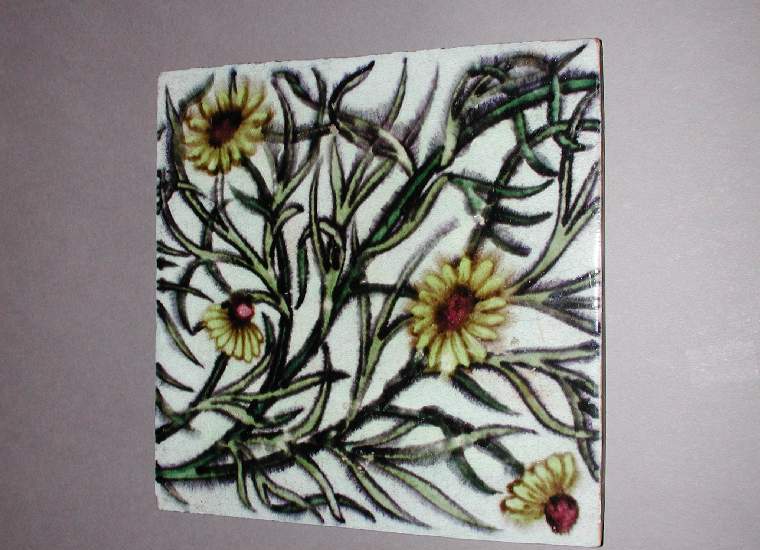Current Location: In storage
Titles
Tile with ‘Clyde’ daisy design (2)
Maker(s)
Maker:
William De Morgan & Co.
Designer:
De Morgan, William Frend
Entities
Categories
Description
Square, buff, earthenware tile, covered in cream slip, decorated with transfer pattern in blue-black, purple-brown, yellow and shades of green, and glazed. An all-over naturalistic pattern of green leaves, with a diagonal leading stem and four yellow petal, purple-brown centre, daisies. Two of the daisies are shown from the side, with petals bent back. The design is outlined in blue-black, which has smudged in places; the resulting blurred effect is enhanced by a somewhat heavy clear glaze. The tile is thick and the earthenware coarse. There are wide stripes of glaze across the back.
Notes
History note: Given by Mr H C Mossop, 1941
Legal notes
Given by Mr H C Mossop, 1941
Measurements and weight
Width: 20.4 cm
Width: 8 in
Acquisition and important dates
Method of acquisition: Given
(1941-03-26)
by
Mossop, H. C.
Dating
19th Century, Late
1882
CE
-
1888
CE
Note
This tile dates from 1882-88, when De Morgan’s workshop was at Merton Abbey, next door to Morris’s factory. The coarse earthenware and rough sides indicate that the tile was intended for a fireplace or other architectural use. The flowing naturalism suggests it is an early design, perhaps influenced by Morris’s work; De Morgan’s later tile designs were more stylised and symmetrical. He made many, many designs for tiles and tile panels – some 820, including this one, are in the V&A collection – and transferred them using his own innovative transfer method which allowed repeats to be made whilst preserving a ‘hand-made’ quality. There are two tiles of this design in the Fitzwilliam collection, which illustrate the experimental nature of De Morgan’s work. Here the transfer design has blurred; it has been more successfully applied on the other example (C.8-1941).
William Frend De Morgan (1839-1917), now widely regarded as the most important ceramicist of the Arts & Crafts movement, also worked in stained glass and became a successful novelist. The son of a non-conformist mathematics professor, he became a close friend of William Morris and Edward Burne-Jones and married the Pre-Raphaelite painter Evelyn Pickering (1855-1919), in 1887. As a ceramicist, De Morgan was primarily a designer/decorator and chemist, working on bought-in blanks or pots thrown to his design. He experimented widely with techniques and glazes, re-discovering methods for making and applying lustres and the colours of Iznik and Persian pottery and using them for a range of complex fantasy designs featuring ships, birds, flora and animals. This tile has been produced using De Morgan’s invention of tracing and painting the design onto paper which burned away in the kiln, leaving the design fixed under the glaze.
School or Style
Arts and Crafts (movement)
People, subjects and objects depicted
Components of the work
Decoration
Materials used in production
Clear glaze
Earthenware
Techniques used in production
Slip-coating
: Buff coloured earthenware, slip-coated, decorated with polychrome transfer pattern and glazed
Glazing
Inscription or legends present
Inscription present: Large, square, one ‘M’ serving both parts and a drawing of an abbey church
- Text: W DE M Merton Abbey
- Location: On reverse
- Method of creation: Impressed
- Type: Mark
References and bibliographic entries
Identification numbers
Accession number: EC.7-1941
Primary reference Number: 15325
Stable URI
Audit data
Created: Saturday 6 August 2011
Updated: Friday 8 August 2025
Last processed: Friday 8 August 2025
Associated departments & institutions
Owner or interested party:
The Fitzwilliam Museum
Associated department:
Applied Arts




